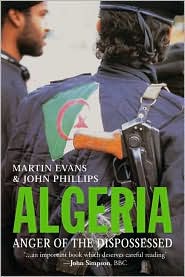|
Reviewed by John Schindler, Ph.D., Professor of National Security Affairs at the U.S. Naval War College Martin Evans and John Phillips have produced an important documentation of Algeria’s fratricidal nightmare of the 1990s, which continues to receive remarkably little attention outside that troubled country. Despite the fact that Algeria’s civil war—which ran at a terrifying tempo from 1992 to 1998—probably claimed twice as many lives as the contemporaneous Bosnian war, it has received only a small fraction of the journalistic, scholarly, and policy coverage of Balkan problems. The reasons for this inattention are not difficult to detect. The Algerian government went to lengths to prevent foreign journalists from covering the fighting, while Islamist rebel groups killed reporters and writers by the dozen. The result has been a yawning gap in Western understanding of what actually happened in Algeria in the last decade. Specifically, there remain troubling questions of what was being done by whom, and why. All that can be said for certain is that jihad-motivated insurgents failed spectacularly to take over Algeria, and tens of thousands of innocents died in the process. For radical Islamists, and al-Qaeda specifically, the uprising was a record-breaking failure, leaving political Islam deeply discredited among most Algerians. Evans and Phillips – the former an academic, the latter a journalist – possess impressive knowledge and experience with Algerian history and culture, which allows both seasoned Maghreb-watchers and neophytes to profit and learn from this well-written and insightful read. The book offers a serviceable survey of recent Algerian history and a useful overview of that country’s political, social and economic problems since independence in 1962. The authors’ attention to the role of popular culture behind many societal problems is noteworthy. Most of the book focuses on Algeria since 1988, the year that the FLN regime began to falter, and devotes most of its pages to the how and why the country plunged into the abyss in the early 1990s—leading to civil war, mass murder, and chaos. Their analysis of how political Islam became such a potent force, seemingly so rapidly, is to be highly praised. No less worthy is their effort to expose the ugly machinations of the regime–what average Algerians term le pouvoir (‘the power’). Evans and Phillips leave no doubt that the military junta that has ruled Algeria de facto for decades, and with an iron grip since 1992, is highly corrupt and willing to employ especial violence to maintain its power. That le pouvoir used very unpleasant methods to defeat al-Qaeda-linked Mujahideen which included anti-terrorist techniques that no Western government would countenance (widespread use of torture, kidnappings, assassinations, and even the killings of civilians to discredit the terrorists), raises troubling questions which Evans and Phillips, unfortunately, ultimately do not answer. It is disappointing that the authors do not fully explore the depths of the depravity shown by the Islamist rebels against Algeria’s civilians. The Armed Islamic Group, or GIA, ranks as the most homicidally violent jihadist element anywhere, having killed civilians intentionally by the thousands. GIA’s descent into the deadly logic of takfir is left largely unexplained, which is unfortunate given its key role in the defeat – really, self-defeat – of the jihad in Algeria. Linkages between GIA and al-Qaeda are similarly left mostly unsaid, despite the significant fact that the leaders of the global jihad movement, appalled by the group’s unfocused violence, withdrew support from GIA by early 1997. Evans and Phillips call attention to the role of Western governments – especially the British and American – in Algeria’s dirty war by elaborating how London and Washington, since 9/11, have been willing to more or less overlook the terrible human rights problems of le pouvoir as long as Algiers remains supportive of the Anglo-American “War on Terror.” This view deserves an airing, and is something the West ought to ponder as it seeks allies in the Muslim world to help defeat al-Qaeda. That said, it is mistaken to present Algeria’s disaster since 1992 as anything other than a mostly homegrown catastrophe. While al-Qaeda and related foreign fighters played a part in the civil war, nearly all the killing—on all sides—has been done by Algerians to Algerians. Evans and Phillips explain lucidly, and acidly, how poverty and corruption have alienated many Algerians, particularly youths without much hope for a decent life. Dispossession, much less the legacy of French colonialism, fails, however, to explain why the civil war has been so exceptionally violent. Here Evans and Phillips leave many questions unanswered. The Algerian sociologist ‘Luis Martinez’ highlighted his country’s “war-oriented imaginaire” as a major culprit behind the savagery in his insightful The Algerian Civil War 1990-1998 (2000), finding ample antecedents to GIA and related criminals-cum-rebels in Algeria’s long traditions of violent piracy. Nevertheless, Evans and Phillips have published a work that deserves attention. It goes some distance to explaining what happened to Algeria since the Cold War’s end, and offers some reasons why. That their answers are incomplete leaves the path open to research by others—which is needed for Algeria’s savage civil war to be fully understood. |


 Algeria:Anger of the Dispossessed
Algeria:Anger of the Dispossessed